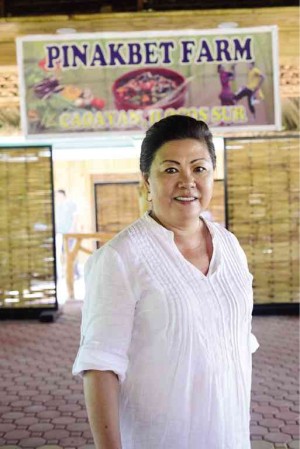
In the middle of a parched land stood a structure made of native materials like bamboo, some split and woven to become sawali. This was the local version of a gazebo, a haven from the heat of the Ilocos summer.
Since it’s located in Pinakbet Farm in Caoayan, Ilocos Sur, the tendency is to look around to see where those pinakbet vegetables grow.
Photographer Patrick Uy knew where to look and discovered the vegetables growing around the place. There was parya (ampalaya, bitter gourd) still attached to the vine and the siling duwag (non-hot green chilis) still on their stems.
There was a cool breeze felt in spite of the climate and it came from a river running on one side. The opportunity to catch some tilapia was taken on by visitors who wanted a complete experience at the farm.
Picnic-style lunch
For something like P200, guests can have lunch consisting of pinakbet, grilled tilapia, chicken and pork, served picnic-style on banana leaves and bamboo containers. Those who know
how to savor Filipino food used their hands.
Caoyan mayor Germy Singson said she had to think of a way to attract visitors to this part of the province, since the majority of tourists trek to Vigan and its heritage houses. Apart from fishing and the lunch, visitors are entertained with dances and songs, all Ilocano, of course.
Vegetables make Ilocano cooking distinct from other regions’ cuisines. But the cooking itself is quite simple—boiling in a slight broth flavored with fish paste (bagoong). Called dinendeng or inabraw, the mix can be eaten at any time of the day. But the mix has to be made of compatible vegetables and other ingredients.
Chef Nick Rodriguez of Bistro Candon in Ilocos Sur enumerated some combinations in a Food magazine feature. He mentioned utong (small sitaw), squash, kabatiti (patola, snake gourd) and sabong kalabasa (squash flowers) that can go together.
Patani (lima beans), alukon (Alanthus glaben), kamote (sweet potato) and malunggay pods (moringa) form the other combination.
A good cook will know just when to add each vegetable, depending on its cooking time. Grilled or fried fish can be added.
‘Dinengdeng’ station
If you knew which vegetables went together, then you didn’t have to be stumped at the dinendeng station of Luna Hotel in Vigan, Ilocos Sur. But if you were aware of the proper combinations, just pointing to the vegetables you fancied would do.
This is a great attempt by the hotel to give travelers a taste of cooking where they are at. It’s also a chance to inquire about unfamiliar vegetables—some with rather risqué names, at least
to Tagalogs—and the chance for trainees from a local culinary school to tell visitors about their province’s cooking.
At Saramsam in Ilocos Norte, the dinendeng was clean-tasting, the vegetables arranged not in the slapdash manner but quite neatly.
La Preciosa, also in Ilocos Norte, served us buridibud to taste—again a vegetable concoction but mixed in with kamote (sweet potato) to sweeten the mix. On top were dried shrimps that are sold by the “can” in many markets.
Pinakbet is the more known vegetable concoction. It has traversed our country such that most restaurant menus now include it in their choices. Each region has added its own favored vegetable to the mix, making the pinakbet quite different from the original.
The addition of squash to pinakbet raises Ilocano eyebrows. My Ilocano father pronounces pinakbet with squash as “mestizo.”
Small variety
If you have to be authentic about pinakbet, the parya and tarong have to be the small variety. And there is a way of slicing those, as we learned when we photographed pinakbet cooking for a book. The tarong has to be cut top and bottom in the form of a cross, but only halfway.
Tarong or talong is transin Ilocos into the best omelet yet, called poqui-poqui or poki-poki. The risqué name is just an adventurous touch to this very simple dish. I was told that the eggplant variety to use should be the green kind, not the violet or aubergine one. Luna Hotel in Vigan, Ilocos Sur, serves the poqui-poqui as a dip, wiped on bread. A trendy variant, but the taste wasn’t altered, to our delight.
At the Vigan market, the two eggplants are at the vegetable section. Some vendors can be removing the tough outer skins of malunggay pods. The katuray (Sesbania grandiflora) flowers look so attractive, a counterpoint to its not-so-attractive name. The sellers are generous enough to tell you the names of their wares, in Ilocano if you asked, and even give you cooking tips.
E-mail the author at pinoyfood04@yahoo.com